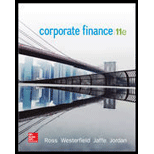
GOODWEEK TIRES, INC.
After extensive research and development, Goodweek Tires, Inc., has recently developed a new tire, the SuperTread, and must decide whether to make the investment necessary to produce and market it. The tire would be ideal for drivers doing a large amount of wet weather and off-road driving in addition to normal freeway usage. The research and development costs so far have totaled about $10 million. The SuperTread would be put on the market beginning this year, and Goodweek expects it to stay on the market for a total of four years. Test marketing costing $5 million has shown that there is a significant market for a SuperTread-type Lire.
As a financial analyst at Good week Tires, you have been asked by your CFO, Adam Smith, to evaluate the SuperTread project and provide a recommendation on whether to go ahead with the investment. Except for the initial investment that will occur immediately, assume all cash flows will occur at year-end.
Goodweek must initially invest $160 million in production equipment to make the SuperTread. This equipment can be sold for $65 million at the end of four years. Goodweek intends to sell the SuperTread to two distinct markets:
1. The original equipment manufacturer (OEM) market: The OEM market consists primarily of the large automobile companies (like General Motors) that buy tires for new ears. In the OEM market, the SuperTrcad is expected to sell for $41 per tire. The variable cost to produce each tire is $29.
2. The replacement market: The replacement market consists of all tires purchased after the automobile has left the factory. This market allows higher margins; Goodweek expects to sell the SuperTread for $62 per tire there. Variable costs are the same as in the OEM market.
Goodweek Tires intends to raise prices at 1 percent above the inflation rate; variable costs will also increase at 1 percent above the inflation rate. In addition, the SuperTread project will incur $43 million in marketing and general administration costs the first year. This cost is expected to increase at the inflation rate in the subsequent years.
Goodweek’s corporate tax rate is 40 percent. Annual inflation is expected to remain constant at 3.25 percent. The company uses a 13.4 percent discount rate to evaluate new product decisions. Automotive industry analysts expect automobile manufacturers to produce 6.2 million new cars this year and production to grow at 2.5 percent per year thereafter. Each new car needs four tires (the spare tires are undersized and are in a different category). Good week Tires expects the SuperTread to capture 11 percent of the OEM market.
Industry analysts estimate that the replacement tire market size will be 32 million tires this year and that it will grow at 2 percent annually. Goodweek expects the SuperTread to capture an 8 percent market share.
The appropriate
To determine: NPV, payback period, discounted payback period, IRR and PI of the project.
Internal Rate of Return (IRR)
The internal rate of return is the discounting rate of capital budgeting in which the NPV of the cash flow of the project comes equally to zero.
Capital Budgeting:
The decision-related to the investment for long run is called capital budgeting. Capital budgeting includes the investment in the heavy machinery and information technology.
Net Present Value (NPV):
The net present value is a differential amount of the net cash inflow from future investments and net cash outflow in the form of cost that the company has to pay at present as initial cost of the investment.
Explanation of Solution
Solution:
Given,
Cost of the project is $160,000,000.
Working capital investment requirement is $9,000,000.
Selling price of per tire is $41.
Market captured by the company is 11%.
Expected car sold is 6,200,000.
Requirement of tires for each car is 4.
Market grow rate is 2.5%.
Annual sale in replacement market is 32,000,000 tires.
Company capture in replacement market is 8%.
Market grow rate in replacement market is 2%.
Variable cost is $29.
Tax rate is 40%.
Discount rate is 13.4%.
Calculation of the payback period,
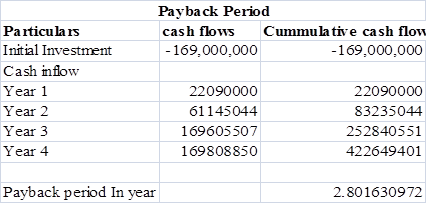
Table (1)
Formula to calculate the profitability index of project:
Substitute, $211,363,957 for the present cash flow and $169,000,000 for the Initial investment,
Calculate the discount payback period of the project,
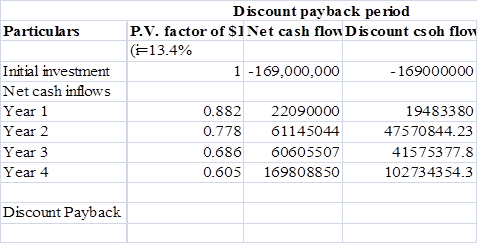
Table (2)
Calculate the net present value of the project,
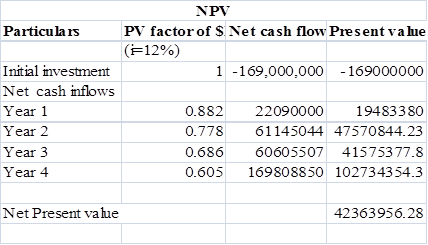
Table (3)
Calculate the Internal rate of return,
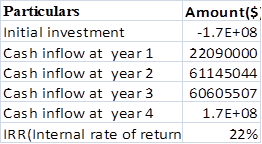
Table (4)
Working notes:
Calculate the nominal growth rate:
Calculate the number of cars sold in automobile market in 2nd year,
Calculate the number of cars sold in automobile market in 3rd year:
Calculate the number of cars sold in automobile market in 4th year:
Calculate the tires sold by the company in OEM market,

Table (5)
Calculate the number of the tires sold in replacement market,

Table (6)
Calculate the total sales value of tires in both the market,
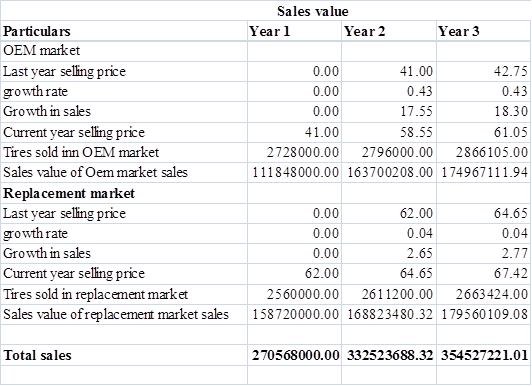
Table (7)
Calculate the variable cost of tire
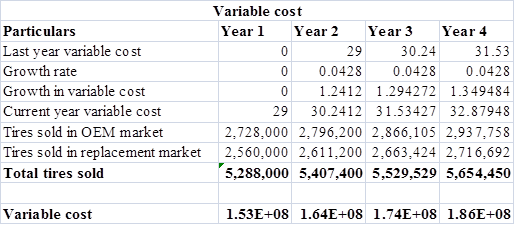
Table (8)
Calculate the depreciation for the 1st year by using the depreciation table:
Calculate the depreciation for the 2nd year by using the depreciation table:
Calculate the depreciation for the 3rd year by using the depreciation table:
Calculate the depreciation for the 4th year by using the depreciation table:
Calculate the value of the salvage value after tax,
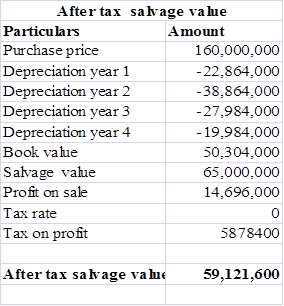
Table (9)
Calculate the change in the working capital,

Table (10)
Calculate the annual market cost,

Table (11)
Calculate the annual cash flow,
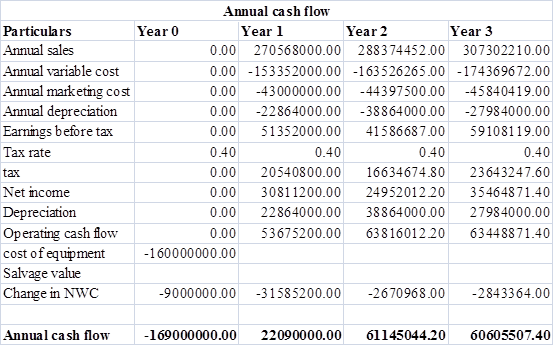
Table (12)
Calculate the present value of the cash flow
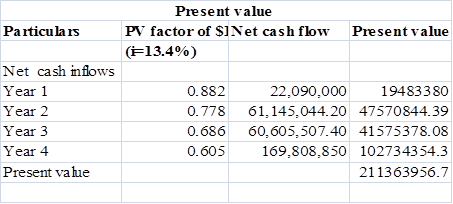
Table (13)
Hence, the NPV is positive and Profitability index is more than 1. So the project should be accepted.
Want to see more full solutions like this?
Chapter 6 Solutions
Corporate Finance (The Mcgraw-hill/Irwin Series in Finance, Insurance, and Real Estate)
- Ends Feb 23 Explain in detail what is Risk as defined for financial assets and what is Beta? Also discuss in detail what is the Capital Asset Pricing Model (CAPM) and its purpose.arrow_forwardThe slope parameter ß1 measures the change in annual salary, in thousands of dollars, when return on equity increases by one percentage point. Because a higher roe is good for the company, we think ß1 > 0.The data set CEOSAL1 contains information on 209 CEOs for the year 1990; these data were obtained from Business Week (5/6/91). In this sample, the average annual salary is $1,281,120, with the smallest and largest being $223,000 and $14,822,000, respectively. The average return on equity for the years 1988, 1989, and 1990 is 17.18%, with the smallest and largest values being 0.5% and 56.3%, respectively.Using the data in CEOSAL1, the OLS regression line relating salary to roe is :arrow_forwardFor the population of people in the workforce in 1976, let y = wage, where wage is measured in dollars per hour. Thus, for a particular person, if wage = 6.75, the hourly wage is $6.75. Let x = educ denote years of schooling; for example, educ =12 corresponds to a complete high school education. Because the average wage in the sample is $5.90, the Consumer Price Index indicates that this amount is equivalent to $24.90 in 2016 dollars.Using the data in WAGE1 where n = 526 individuals, we obtain the following OLS regression line (or sample regression function):arrow_forward
- Define the following: Callable bond Puttable bond Zero-coupon bond Premium bond Discount bond Crossover bonds Even though most corporate bonds in the United States make coupon payments semiannually, bonds issued elsewhere often have annual coupon payments. Suppose a German company issues a bond with a par value of EUR 1,000, 15 years to maturity, a coupon rate of 7.2%. If the yield to maturity is 6.3%, what is the current price of the bond? Rhiannon Corporation has bonds on the market with 13 years to maturity, a YTM of 7.6%, a par value of $1,000, a current market price of $1,075. The bonds make semiannual payments. What must the coupon rate be on these bonds? What would be coupon rate if the current market price is $962.68? What would be the coupon rate if the bonds make quarterly payments? Suppose that a bond has a face value of $1,000 and a YTM of 8% per annum. If the bond pays monthly coupons with an annual coupon rate of 9.6%, what will be the current price of…arrow_forwardWildcat, Incorporated, has estimated sales (in millions) for the next four quarters as follows: Q1 Q2 Q3 Sales $ 195 $ 215 $ 235 Q4 $ 265 Sales for the first quarter of the following year are projected at $210 million. Accounts receivable at the beginning of the year were $83 million. Wildcat has a 45-day collection period. Wildcat's purchases from suppliers in a quarter are equal to 50 percent of the next quarter's forecast sales, and suppliers are normally paid in 36 days. Wages, taxes, and other expenses run about 20 percent of sales. Interest and dividends are $18 million per quarter. Wildcat plans a major capital outlay in the second quarter of $98 million. Finally, the company started the year with a $84 million cash balance and wishes to maintain a $40 million minimum balance. a-1. Assume that Wildcat can borrow any needed funds on a short-term basis at a rate of 3 percent per quarter and can invest any excess funds in short-term marketable securities at a rate of 2 percent per…arrow_forwardConsider the following two bonds: Bond A Bond B Face value $1,000 $1,000 Coupon rate (annual) 8% 8% YTM 9% 7% Maturity 10 years 10 years Price (PV) ? ? Calculate the price for each bond. What is the primary factor affecting the prices of the bonds? Indicate which bond is premium and which one is discount. Is there any relationship between the YTM and the coupon rate in case of premium/discount bonds? Now, consider the following two bonds: Bond X Bond Y Face value $1,000 $1,000 Coupon rate (annual) 8% 8% YTM 11% 11% Maturity 5 years 10 years Price (PV) ? ? Calculate the price for each bond. What is the relationship between bond price and maturity, all else equal? A bond with a par value of $1,000 and a maturity of 8 years is selling for $925. If the annual coupon rate is 7%, what’s the yield on the bond? What would be the yield if the bond had semiannual payments?…arrow_forward
- Don't used hand raitingarrow_forwardDon't used Ai solutionarrow_forwardAssume an investor deposits $116,000 in a professionally managed account. One year later, the account has grown in value to $136,000 and the investor withdraws $43,000. At the end of the second year, the account value is $107,000. No other additions or withdrawals were made. During the same two years, the risk-free rate remained constant at 3.94 percent and a relevant benchmark earned 9.58 percent the first year and 6.00 percent the second. Calculate geometric average of holding period returns over two years. (You need to calculate IRR of cash flows over two years.) Round the answer to two decimals in percentage form.arrow_forward
- Principles of Accounting Volume 2AccountingISBN:9781947172609Author:OpenStaxPublisher:OpenStax College
 Cornerstones of Cost Management (Cornerstones Ser...AccountingISBN:9781305970663Author:Don R. Hansen, Maryanne M. MowenPublisher:Cengage Learning
Cornerstones of Cost Management (Cornerstones Ser...AccountingISBN:9781305970663Author:Don R. Hansen, Maryanne M. MowenPublisher:Cengage Learning EBK CONTEMPORARY FINANCIAL MANAGEMENTFinanceISBN:9781337514835Author:MOYERPublisher:CENGAGE LEARNING - CONSIGNMENT
EBK CONTEMPORARY FINANCIAL MANAGEMENTFinanceISBN:9781337514835Author:MOYERPublisher:CENGAGE LEARNING - CONSIGNMENT


